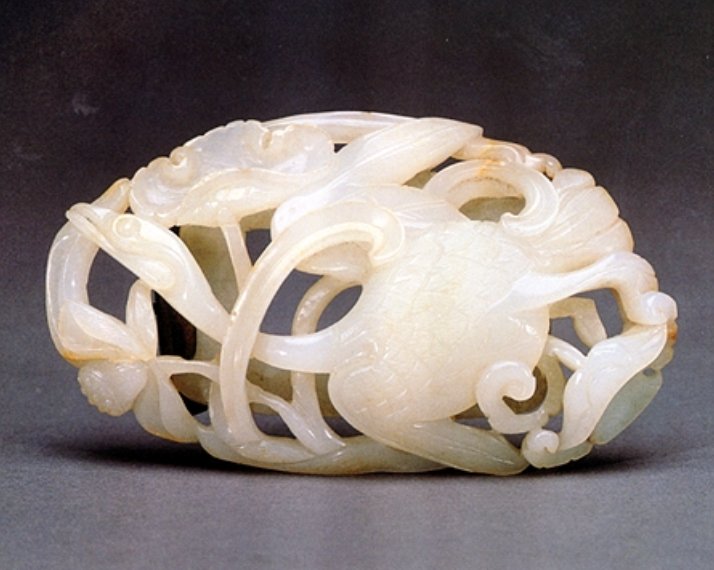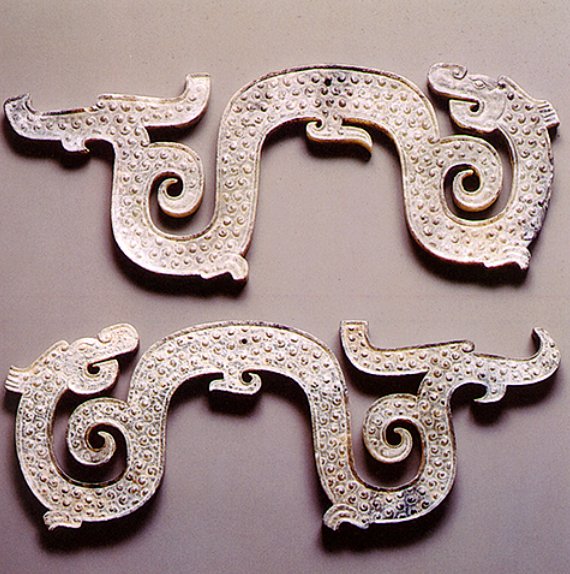A7: The One Word for
All Chinese Arts
Many
years ago I was shown two jade dragons. They looked exactly the same
and were sold at high prices in an international auction. I was asked which was
the original and which was the imitation. They both looked very, very beautiful
and shining. I did not know the answer. Then the man asked me which one had
better energy flow or connection. I still had no idea. Then he gave me a hint,
“which has more wholeness in design?” Then I was able to figure out.
In
appreciating “all” Chinese arts, the first criterion will be the energy
flow, or Chi (Qi 氣
),
or life force, or connection of wholeness. If the stalk of a plant is drawn with
many strokes and each stroke is amended several times, the plant will look like
being torn apart and then glued back. But if the stalk is drawn with appropriate
number of strokes or just one metaphysical stroke, the plant will look vivid or
transcendental.
In
judging Chinese arts, we look for the energy flow since the intrinsic beauty can
only be found within the art that embodies a high energy and awareness level
from the artists. This principle can be applied to all Chinese arts. Unlike oil
painting, most Chinese arts emphasize and value the skills without amendments.
One may add more strokes over an unsatisfied area in oil painting, but Chinese
arts focus on capturing the mindset at that very moment when an artist is
creating the work – without any makeup. Unlike other visual arts, all strokes
in Chinese calligraphy are permanent and incorrigible. It’s because this
“finality” that makes Chinese calligraphy extremely difficult to master.
Chinese calligraphy, painting, and seal making thus deserve more merits than
many forms of arts in the mind of most Chinese people.
|

Jade
Belt Buckle with Wild Goose Design
Yuan to Ming Dynasty (1271-1368)
11.2 x 6.2 cm
This
ovoid belt buckle is carved in translucent white nephrite with a waxy
luster. The obverse depicts in layered openwork a wild goose scurrying
through the reeds of a lotus pond. The reverse is fitted with a
rectangular jade frame of a scepter cloud design in low relief with two
inlaid copper clasps for fastening to a belt.
|
This
jade adornment retains the oval shape and style of its predecessors in the Yuan
Dynasty. The gradations are complex but not erratic, and lines are rounded and
fluid. The inside is as delicate as the outside. If the artist did not have
enough physical energy and mental focus, he had no way to carve inside the jade
without disrupting the “wholeness” – the “oneness” of that unique piece
of art.
|

Dragon-shaped
pendant (Pair)
Warring
States Period (403 –221 BC)
20.5
x 7.8 x 0.75 cm
This
pair of pendants is carved from light yellowish-green nephrite (jade)
speckled with gray and black. These pendants are covered with a thin
layer of ashen spots and carved into the impressive semblance of large
coiling dragons. The designs on the obverse and reverse are identical,
with the curled snouts and manes extending to the front and back
respectively. The chins are arced and a gap separates the upper and
lower jaws, while the cheeks are adorned with an oblique and checkered
shield design. The serpentine bodies are embellished with spiraled hooks
and carved with rows of “Gu
穀
”
(grain) patterns. Many of the hooks are carved with hair-tuft patterns,
typical of the Warring States style. |
We
may have noticed
that the torsos of the dragons resemble the stokes of Zuan Style calligraphy.
The spacing, structure, and energy flow are quite in correspondence with Zuan
Style. (Please refer to the illustrations in A9: How to Self
Criticize.)
Today
me may see a beautiful jade dragon with long twisted torso. Even though we have
better technology today, we can never see the depth of the spiritual beauty and
delicacy of a dragon in a machine processed jade as in an ancient jade. Because
most of the ancient artists had a higher level of physical endurance and mind
focus, their energy flow and life force were shown in their works and revealed
to us more intrinsic beauty of the art and artist.
Jade were almost certainly used
by the highest nobility as emblems of status in ancient China.
Chinese
believe that jade has a special kind of energy to bring luckiness and avoid or
circumvent disasters. They say that if a group of people walking across the street are hit
by a vehicle, the one wearing a jade would least likely to get injured. Thus, the
Chinese saying “The man survived with a broken jade.”
More
links about Chinese jade:
 http://www.comp.nus.edu.sg/~yuenck/hist/jade.htm
http://www.comp.nus.edu.sg/~yuenck/hist/jade.htm
 http://www.npm.gov.tw/en/e04010800.htm
http://www.npm.gov.tw/en/e04010800.htm
Articles
Menu
Home
